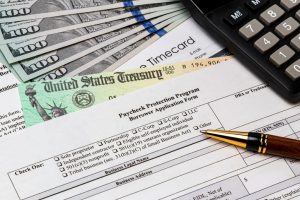 Good news for small businesses—another stimulus package has been approved! The new package provides $900 billion in coronavirus relief and stimulus. Its provisions include an extension of last spring’s Paycheck Protection Program (PPP), allowing another $284 billion or so in forgivable, federally backed loans for ailing small businesses. And it provides some much needed relief for individuals.
Good news for small businesses—another stimulus package has been approved! The new package provides $900 billion in coronavirus relief and stimulus. Its provisions include an extension of last spring’s Paycheck Protection Program (PPP), allowing another $284 billion or so in forgivable, federally backed loans for ailing small businesses. And it provides some much needed relief for individuals.
The initial program, overseen by the U.S. Department of Treasury and Small Business Administration, provided $525 billion to more than 5 million recipients. It was first instituted under the CARES Act back in March 2020. Its purpose was to put funds in the hands of businesses who were increasingly being forced to close their doors due to coronavirus in the hopes that the money would prevent layoffs by funding these businesses’ payrolls. The loans could be fully forgiven if the businesses spent at least 60% of the proceeds on payroll costs.
The first iteration of the PPP was a success with tens of thousands of businesses receiving hundreds of billions of dollars that went toward keeping people in their jobs. It was such a success that business owners and elected officials have been lobbying for a second round of the program to be included in any future COVID-19 related stimulus package. This week, they got their wish!
Things to Know About the New PPP Act
The new PPP Act provides assistance to small businesses in part by revamping PPP, which contained loopholes and liabilities that raised countless issues. Whether you already have an existing PPP loan, are interested in obtaining a PPP loan, or want to obtain a PPP second draw, the new PPP Act makes changes to PPP rules that may be relevant to small businesses. These are some things to know about the new PPP Act:
Get Your Planning in Place in the New Year!
For anyone who does not have their planning in place, the new year is an ideal time to do so for many reasons, one of which is peace of mind! Here at the Farr Law Firm, we have strategies to help everyone plan for themselves and their loved ones. With advance planning, each person can retain the income and assets it has taken a lifetime to accumulate, and provide themselves the peace of mind that they are prepared should something happen to them or their loved one.
If you or your loved ones have not done Incapacity Planning or Estate Planning, or if a loved one needs nursing home care or even if your loved one is already in a nursing home, please contact us as soon as possible to make an appointment for an initial consultation:
Elder Law Fairfax: 703-691-1888
Elder Law Fredericksburg: 540-479-1435
Elder Law Rockville: 301-519-8041
Elder Law DC: 202-587-2797












